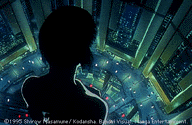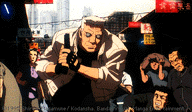Ghost In The Shell's Official Premiere -- In Japan
Ghost in the Shell (called Koukaku Kidotai in Japanese),
planned for release in the US by
Manga Entertainment
in the winter of 1996, had its "official" Japanese premiere at the
Togekki Cinema in the Higashi Ginza section of Tokyo on 18 November
1995. As part of the premiere, special guests were director Mamoru
Oshii, music director Kawai Kenji, computer graphics designer Tanaka
Seiji, and the voice of Kusanagi Motoko, Tanaka Atsuko (no relation).
After a short interview of the four by the emcee a translated note from
James Cameron to the Ghost staff present was read aloud, praising
the group for their efforts, their vision, and their success in
bringing Masamune Shirow's work to the big screen. With that, the
flowers were handed out to the quartet, and the show began.

The movie starts with the hero, Motoko, "neutralizing" someone who
was trying to have a private meeting with a programmer of Project 2501.
The action in the scene is one of those eye-popping moments that
captures everyone's attention, and gives the viewer a near-addictive
taste of things to come. The animation, while spectacularly clear and
fluid, has to play a back seat to the abilities of the staff who
organized the scene. Overall though, the animation alone is excellent,
and when combined with the first-rate computer graphics Ghost
has, it sets a standard that future animated features will most likely
be measured by for quite a while. From the prologue to the chase through
the marketplace to the final battle, this hybridized animation again
and again did things that normal animators would definitely have
significant difficulty trying to achieve -- and did them better than
all its predecessors.

However, this movie cannot (and does not) stand on its animation alone.
The soundtrack, by Kawai Kenji, is excellent in its abilities to
complement and amplify the mood the animation and direction convey to
the viewer -- despite obvious repitition. The opening theme alone is
wonderful, but only shows at most half of what Mr. Kawai was able to
do for Ghost. Also, the powerful and steady direction or
Mr. Oshii helped tie it all together. For those that enjoyed the second
Patlabor movie, this definitely has the same style. The interplay
between the Puppet Master, Motoko, and Bateau is VERY well done, and
gives the movie an excellent sense of balance in contrast to the actions
of Section 9 and those behind Project 2501. Also, while Ghost in the
Shell gives viewers a look into the dirty tricks and special
operations that happen in the shadowy recesses of governments, it also
looks at the human side of it all. What happens to you when you scrap
all but 10% or so of your flesh to become superhuman? What kind of
person do you have to be? What kind of person do you become? Are you
human, or aren't you?
All of this, wrapped together, gives Ghost remarkable appeal to
SciFi, action, and anime fans alike. The heated discussion of many a
Japanese viewer and the long wait at in lines to buy Ghost in the
Shell-related goods after the movie being a decent indicator. While
this issue has a synopsis and other tidbits are available via other
resources, you really HAVE to see the movie at least once to get the
full effect of it all. As to that, all I can say is wait -- it'll
be worth it.
--Theo Moon
|
|
The Technology of 2029
In Masamune Shirow's world of Ghost in the Shell, people can
'jack' into vehicles and computers to control them, replace hands with
high-speed typing prostheses, and even replace their bodies completely,
giving superhuman strength, speed, and endurance. But the technical
advances of Ghost in the Shell is not just limited to
cyber-enhancements...
Thermo-Optic: Based on the same priniciple as that of the Predator,
this skin-tight suit bends light around it, giving the illusion of
invisibility to its wearer. A thermographic visor lets the wearer see
his surroundings in terms of relative heat.
Floater: This is a diving tool worn on the back that serves as an
air bladder for cyborgs, allowing them to float in water despite their
body's total inability to.
Mateber M2007: This six-shot revolver is Togusawa's weapon of
choice (to Motoko's chagrin). Probably the equivalent of a police .38
caliber in 2029.
Zastaber CZ-M100: This clip-fed gun is officially still in the
prototype stage, but is much more practical than the Mateber for various
reasons.
Nine Weapon CZN-M23: As it says, this assault rifle has modular
parts to allow it to have nine different configurations, depending on the
situation. An option is the Unit B, an add-on to the core of the nine
weapon that gives it more of a punch, although it is still an
anti-personnel weapon. The core weapon itself looks like a smaller,
lighter version of a MAC-10/Uzi cross. This is standard issue for
Section 9, and apparently one of Motoko's preferred weapons.
The Penetrator: Looking more like a piece of construction
equipment than a weapon, Bateau uses this in the latter half of the
movie. I'd say more, but I think I might spoil it for those reading...
Snipers in 2029 operate out of their own breed of helicopter.
After reaching the target site, the interior of the helicopter folds out
and lowers a platform that is actually an very advanced and precise
gyro-stabiliser. This allows the helicopter to stay mobile but still give
the snipers not only a quick way out after the hit, but more of an
opportunity to hit their target.
Military pilots are linked into their vehicles as a rule. With a
virtual reality system on their head that gives them unlimited vision of
the surrounding area and instant tactical information, they are the
ultimate pilots.
The airliners of 2029 are huge, utterly massive things that not
only are ugly as sin, but apparently amphibious.
Dispatchers, or HQ operators jack into a computer to control the
forces at their command. Looking like dolls or mannequins when first seen,
they are actually AIs in robotic bodies.
To see more, I'm afraid you'll have to go see the movie yourself --
or at least wait until the ads come out, whenever Manga Entertainment
gets to them. Either way, I guarantee that you will be blown away.
|



